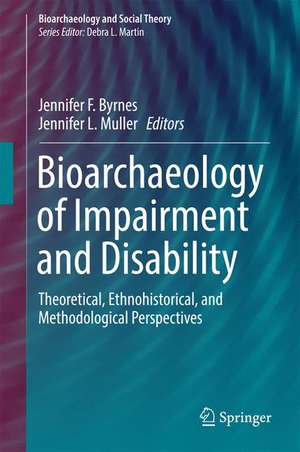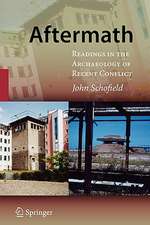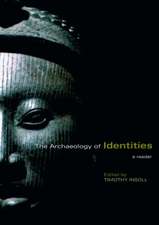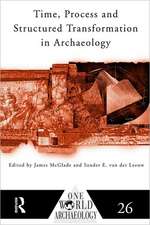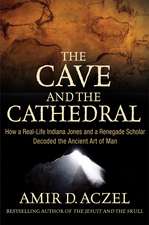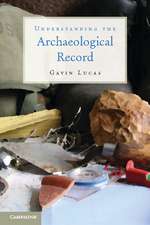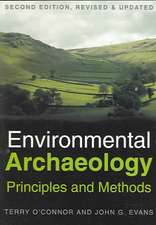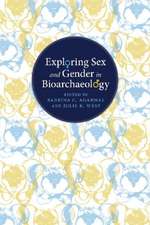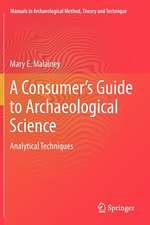Bioarchaeology of Impairment and Disability: Theoretical, Ethnohistorical, and Methodological Perspectives: Bioarchaeology and Social Theory
Editat de Jennifer F. Byrnes, Jennifer L. Mulleren Limba Engleză Hardback – 11 iul 2017
This volume serves to engage scholars from many disciplines in our exploration of disability in the past, with particular emphasis on the bioarchaeological context.
| Toate formatele și edițiile | Preț | Express |
|---|---|---|
| Paperback (1) | 890.54 lei 43-57 zile | |
| Springer International Publishing – 2 aug 2018 | 890.54 lei 43-57 zile | |
| Hardback (1) | 896.52 lei 43-57 zile | |
| Springer International Publishing – 11 iul 2017 | 896.52 lei 43-57 zile |
Din seria Bioarchaeology and Social Theory
-
 Preț: 357.04 lei
Preț: 357.04 lei - 18%
 Preț: 732.70 lei
Preț: 732.70 lei - 20%
 Preț: 538.73 lei
Preț: 538.73 lei -
 Preț: 394.12 lei
Preț: 394.12 lei - 18%
 Preț: 1117.34 lei
Preț: 1117.34 lei -
 Preț: 391.99 lei
Preț: 391.99 lei - 18%
 Preț: 738.06 lei
Preț: 738.06 lei - 15%
 Preț: 701.06 lei
Preț: 701.06 lei - 15%
 Preț: 585.57 lei
Preț: 585.57 lei - 15%
 Preț: 697.97 lei
Preț: 697.97 lei - 18%
 Preț: 728.11 lei
Preț: 728.11 lei - 18%
 Preț: 731.10 lei
Preț: 731.10 lei - 15%
 Preț: 498.79 lei
Preț: 498.79 lei - 18%
 Preț: 953.03 lei
Preț: 953.03 lei - 18%
 Preț: 890.37 lei
Preț: 890.37 lei - 18%
 Preț: 726.55 lei
Preț: 726.55 lei -
 Preț: 385.47 lei
Preț: 385.47 lei - 24%
 Preț: 683.08 lei
Preț: 683.08 lei - 24%
 Preț: 863.80 lei
Preț: 863.80 lei - 24%
 Preț: 733.59 lei
Preț: 733.59 lei - 15%
 Preț: 643.34 lei
Preț: 643.34 lei
Preț: 896.52 lei
Preț vechi: 1093.31 lei
-18% Nou
Puncte Express: 1345
Preț estimativ în valută:
171.54€ • 179.59$ • 141.95£
171.54€ • 179.59$ • 141.95£
Carte tipărită la comandă
Livrare economică 07-21 aprilie
Preluare comenzi: 021 569.72.76
Specificații
ISBN-13: 9783319569482
ISBN-10: 3319569481
Pagini: 292
Ilustrații: XI, 292 p. 30 illus., 15 illus. in color.
Dimensiuni: 155 x 235 x 23 mm
Greutate: 0.6 kg
Ediția:1st ed. 2017
Editura: Springer International Publishing
Colecția Springer
Seria Bioarchaeology and Social Theory
Locul publicării:Cham, Switzerland
ISBN-10: 3319569481
Pagini: 292
Ilustrații: XI, 292 p. 30 illus., 15 illus. in color.
Dimensiuni: 155 x 235 x 23 mm
Greutate: 0.6 kg
Ediția:1st ed. 2017
Editura: Springer International Publishing
Colecția Springer
Seria Bioarchaeology and Social Theory
Locul publicării:Cham, Switzerland
Cuprins
1 Mind the Gap: Bridging Disability Studies and Bioarchaeology - An Introduction.- Part ITheoretical Perspectives on Impairment and Disability.- 2 Accommodating Critical Disability Studies in Bioarchaeology.- 3 Consideration of Disability from the Perspective of the Medical Model.- 4 Historiography of Disablement and the South Asian context: The case of Shah Daula’s chuhas.- Part II Ethnohistorical Interpretations: Ability, Disability, and Alternate Ability.- 5 Differently Abled: Africanisms, Disability and Power in the Age of Transatlantic Slavery.- 6 Kojo’s Dis/ability: The Interpretation of Spinal Pathology in the Context of an 18th-Century Jamaican Maroon Community.- 7 Rendered unfit: “Defective” children in the Erie County Poorhouse.- Part III Quantitative Methods in Impairment and Disability: Bioarchaeological Approaches.- 8 The Bioarchaeology of Back Pain.- 9 Using Population Health Constructs to Explore Impairmentand Disability in Knee Osteoarthritis.- 10 Quantifying Impairment and Disability in Bioarchaeological Assemblages.- 11 Injuries, Impairment, and Intersecting Identities: The Poor in Buffalo, NY 1851-1913.- Part IV Case Studies of Impairment and Disability in the Past.- 12 Impairment, Disability, and Identity in the Middle Woodland Period: Life at the Juncture of Achondroplasia, Pregnancy, and Infection.- 13 Attempting to Distinguish Impairment from Disability in the Bioarchaeological Record: An Example from DeArmond Mound (40RE12) in East Tennessee.- 14 Anglo-Saxon Concepts of Dis/ability: Placing Disease at Great Chesterford in its Wider Context.
Notă biografică
Jennifer F. Byrnes is an Assistant Professor in the Division of the Social Sciences at the University of Hawaiʻi – West Oʻahu, USA. She received her B.S. in Biology from the State University of New York College at Geneseo (2006), and M.A. (2009) and Ph.D. (2015) in Anthropology from the State University of New York at Buffalo. She has received training in bioarchaeology and forensic anthropology. She co-organized a symposium, of which this volume is a product of, entitled Embodying Impairment: Towards a Bioarchaeology of Disability at the American Association of Physical Anthropology 2015 Annual Meeting. She has most recently published articles in the Journal of Forensic Sciences on a collaborate project with the Defense POW/MIA Accounting Agency as well as another research article which presented the practical considerations of portable X-ray fluorescence with osseous materials. She has ongoing research investigating the traumatic injuries and paleopathology of the adult skeletal remains exhumed from the Erie County Poorhouse in Buffalo, NY.
Jennifer L. Muller is an Associate Professor in the Department of Anthropology, Ithaca College, Ithaca, Nw York, USA. She received her PhD from the Department of Anthropology, State University of New York at Buffalo in 2006. Muller’s research embraces the holism of anthropological study, integrating theoretical perspectives and methodologies from the cultural, biological, and archaeological subfields of the discipline. Her research has specifically focused on how discrimination-based inequities impact human biology in African diasporic populations and among the institutionalized poor. Foundational to this research is the understanding that the body is both biological and social, and that the insidious and pervasive attributes of structural violence may assault the body in a multitude of ways. Muller also examines postmortem structural violence; the idea that discriminatory practices continue to harm the poor and marginalized after death. Muller’s dissertation focused on the relationships between traumatic injuries and inequity in the W. Montague Cobb Human Skeletal Collection housed at Howard University in the District of Columbia, USA. Her research on the institutionalized poor has included bioarchaeological and/or historical analysis from New York State poorhouses, including: the Monroe County Poorhouse, Rochester; the Erie County Poorhouse, Buffalo; and the St. Lawrence County Poorhouse, Canton.
Textul de pe ultima copertă
Over the years, impairment has been discussed in bioarchaeology, with some scholars providing carefully contextualized explanations for their causes and consequences. Such investigations typically take a case study approach and focus on the functional aspects of impairments. However, these interpretations are disconnected from disability theory discourse. Other social sciences and the humanities have far surpassed most of anthropology (with the exception of medical anthropology) in their integration of social theories of disability.
This volume has three goals: The first goal of this edited volume is to present theoretical and methodological discussions on impairment and disability. The second goal of this volume is to emphasize the necessity of interdisciplinarity in discussions of impairment and disability within bioarchaeology. The third goal of the volume is to present various methodological approaches to quantifying impairment in skeletonized and mummified remains.
This volume serves to engage scholars from many disciplines in our exploration of disability in the past, with particular emphasis on the bioarchaeological context.
This volume serves to engage scholars from many disciplines in our exploration of disability in the past, with particular emphasis on the bioarchaeological context.
Caracteristici
Discusses disciplinary boundaries through the engagement of social theories in the interpretations of impairment and disability in the past Features research that examines the documentary, iconological, ethnographic, archaeological, and skeletal archives in order to explore the historical, social, and biological causes and consequences of disability Explores what it means to be disabled and/or impaired within particular temporal and cultural contexts Includes supplementary material: sn.pub/extras Includes supplementary material: sn.pub/extras
